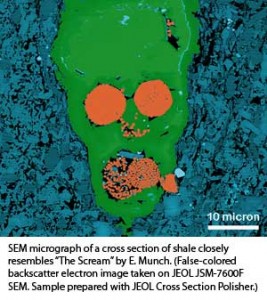In the wake of Craig Venter’s announcement (last week) of the creation of a synthetic organism (or most of one), Barack Obama, US President, has requested a special study (click here to see the letter to Dr. Amy Gutmann of the Presidential Commission for the Study of Bioethical Issues). From Andrew Maynard’s 2020 Science blog (May 26, 2010) posting,
It’s no surprise therefore that, hot on the heels of last week’s announcement, President Obama called for an urgent study to identify appropriate ethical boundaries and minimize possible risks associated with the breakthrough.
This was a bold and important move on the part of the White House. But its success will lie in ensuring the debate over risks in particular is based on sound science, and not sidetracked by groundless speculation.
The new “synthetic biology” epitomized by the Venter Institute’s work – in essence the ability to design new genetic code on computers and then “download” it into living organisms – heralds a new era of potentially transformative technology innovation. As if to underline this, the US House of Representatives Committee on Energy and Commerce will be hearing testimony from Craig Venter and others on the technology’s potential on May 27th – just days after last week’s announcement.
Andrew goes on to suggest while the ethical issues are very important that safety issues should not be shortchanged,
The ethics in particular surrounding synthetic biology are far from clear; the ability to custom-design the genetic code that resides in and defines all living organisms challenges our very notions of what is right and what is acceptable. Which is no doubt why President Obama wasted no time in charging the Presidential Commission for the Study of Bioethical Issues to look into the technology.
But in placing ethics so high up the agenda, my fear is that more immediate safety issues might end up being overlooked.
Hilary Sutcliffe in an opinion piece for ethicalcorp.com (writing to promote her organization’s [MATTER] Corporate responsibility and emerging technologies conference on June 4, 2010) suggests this,
Though currently most of the attention is focused on the scientists exploring synthetic biology in universities, this will also include the companies commercialising these technologies.
In addition, many organisations may soon have to consider if and how they use the applications developed using these new technologies in their own search for sustainability.
This is definitely an issue for the ‘Futures’ area of your CSR [corporate social responsibility] strategy, but there is a new ‘ology’ which is being used in products already on the market which may need to be moved up your priority list – ‘Nanotechnology’ or (‘nanotechnologies’ to be precise) – nano for short.
What I’m doing here is drawing together synthetic biology, nanotechnology, safety, and corporate social responsibility (CSR). What follows is an example of a company that apparently embraced CSR.
In the wake of BP’s (British Petroleum) disastrous handling of the Gulf of Mexico oil spill, the notion of corporate social responsibility and ethics and safety issues being considered and discussed seriously seems unlikely. Sure, there are some smaller companies that act on on those values but those are the values of an owner and are not often seen in action in a larger corporate entity and certainly not in a multinational enterprise such as BP.
Spinwatch offers an intriguing perspective on corporate social responsibility in an article by Tom Borelli,
To demonstrate “responsibility”, BP spent huge sums of money on an advertising campaign promoting the notion that fossil fuel emissions of carbon dioxide is to blame for global warming and its investment in renewable energy was proof the company was seeking a future that was “beyond petroleum”.
The message was clear: oil is bad for society and BP is leading the way in alternative energy.
The BP experience shows there are serious consequences when companies demagogue against its core business. …
… “If you drew up a list of companies that Americans are most disappointed in, BP would definitely feature,” said James Hoopes, professor of business ethics at Babson College, Massachusetts.
Ironically, BP’s experience delivered the exact opposite of CSR’s promise: the company’s reputation was ruined, the company is the target of government agency investigations and Congressional hearings and its stock price lags far behind its competitors and the S&P 500.
Unfortunately, in the aftermath of BP’s failures, many critics blamed corporate greed – not CSR – as the cause. They believed the profit motive forced the company to skimp on basic pipeline maintenance and worker safety.
This conclusion is far from the truth. If profit were its only goal, BP would define its role in society as a company that safely producing oil while providing jobs and energy for the economy.
This article was written in 2006 and presents a view that would never have occurred to me. I find Borelli’s approach puzzling as it seems weirdly naïve. He seems to be unaware that large companies can have competing interests and while one part of an enterprise may be pursuing genuine corporate social responsibility another part of the enterprise may be pursuing goals that are antithetical to that purpose. Another possibility is that the company was cynically pursing corporate social responsibility in the hope that it would mitigate any backlash in the event of a major accident.
Getting back to where this started, I think that nanotechnology, synthetic biology and other emerging technologies require all of the approaches to ethics, safety rules, corporate social responsibility, regulatory frameworks, and more that we have and can dream up including this from Andrew (from May 26, 2010 posting),
Rather, scientists, policy makers and developers urgently need to consider how synthetic biology might legitimately lead to people and the environment being endangered, and how this is best avoided.
What we need is a science-based dialogue on potential emergent risks that present new challenges, the plausibility of these risks leading to adverse impacts, and the magnitude and nature of the possible harm that might result. Only then will we be able to develop a science-based foundation on which to build a safe technology.
Synthetic biology is still too young to second-guess whether artificial microbes will present new risks; whether bio-terror or bio-error will result in harmful new pathogens; or whether blinkered short-cuts will precipitate catastrophic failure. But the sheer momentum and audacity of the technology will inevitably lead to new and unusual risks emerging.
And this is precisely why the safety dialogue needs to be grounded in science now, before it becomes entrenched in speculation.
You can read more about the science behind Venter’s work in this May 22, 2010 posting by Andrew and Gregor Wolbring provides an excellent roundup of the commentary on Venter’s latest achievement.
I agree we need the discussion but grounding the safety dialogue in science won’t serve as a prophylactic treatment for public panic. I believe that there is always an underlying anxiety about science, technology, and our place in the grand scheme of things. This anxiety is played out in various horror scenarios. I don’t think it’s an accident that interest in vampires, werewolves, and zombies is so high these days.
I had a minor epiphany—a reminder of sorts—the other night watching Zombiemania ( you can read a review of this Canadian documentary here) when I heard the pioneers, afficionados and experts comment on the political and social implications of zombie movies (full disclosure: I’m squeamish so I had to miss parts of the documentary).This fear of losing control over nature and destroying the natural order (reversing death as zombies and vampires do) and the worry over the consequences of augmenting ourselves (werewolves, zombies and vampires are stronger than ordinary humans who become their prey) is profound.
Venter’s feat with the bacterium may or may not set off a public panic but there is no question in my mind that at least one will occur as synthetic biology, biotechnology, and nanotechnology take us closer to real life synthetic and transgenic organisms, androids and robots (artificial humans), and cyborgs (body hackers who integrate machines into their bodies).
Let’s proceed with the discussions about safety, ethics, etc. on the assumption that there will be a public panic. Let’s make another assumption, the public panic will be set off by something unexpected. For the final assumption, a public panic may be just what we need. That final comment has been occasioned by Schumpeter’s notion of ‘creative destruction’ (Wikipedia essay here). While the notion is grounded in economics, it has a remarkably useful application as a means of understanding social behaviour.

